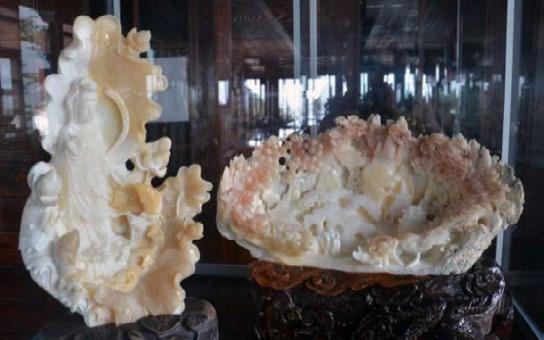
3 minute read
China’s elephant ivory trade ban and the use of substitute materials
Domestic trade in elephant ivory ceased in China at the end of 2017 when a national ban came into force.46 Prior to this, in early 2006, traditional Chinese ivory carving skills were listed as an “intangible national heritage”.47 A handful of factories and carving masters from Beijing and Guangzhou appear on the list of specialised carvers, representing two distinguishable styles, northern and southern. In 2016 when the complete ban on ivory trade was announced, the State Council notice specifically encouraged the transformation of ivory carving skills “to initiate the rescue of such intangible national and provincial heritage” and “to direct using replacement materials to develop other ivory carving and bone carving skills.”48
By promoting the use of alternative materials in the carving industry and enabling a continuing market for these products, the directive is in effect raising the potential risk of increased trade and demand for ivory substitutes. In this context, the May 2021 seizure of 1,300 kg of raw shells from the processing factory in Qionghai City, Hainan province, the eight cases of giant clam shell seizures converging with elephant ivory and other ivory-like products, and the unconfirmed destination of the vast giant clam shell stockpiles in the Philippines, are all the more concerning.
Advertisement
Furthermore, the active promotion of markets for “replacement” ivory materials could also perpetuate demand for elephant ivory as the “ultimate” ivory product. Where demand continues to exist, it will likely lead to the market being driven underground. Although China’s strict law enforcement approach to elephant ivory may go some way towards dampening demand, the sustained trade of substitute materials will likely pose an ongoing threat to elephants in the long-term.
Image 18: Tridacna gigas shell. Credit: Dimitris Vetsikas/ Pixabay.
46 http://www.gov.cn/zhengce/content/2016-12/30/content_5155017.htm 47 http://www.ihchina.cn/project_details/14002 48 http://www.gov.cn/zhengce/content/2016-12/30/content_5155017.htm
An example of the potential impact of this directive can be seen with mammoth ivory trade in China. In 2017, as the elephant ivory trade ban was being phased in, mammoth ivory stopped being considered an exclusive collector’s product and appeared to become an authentic substitute for elephant ivory. Mammoth ivory is currently legal to trade in China with a permit, and it went from being sold only in specialty shops, to carvers and vendors switching to it to mass produce smaller jewellery and chopsticks.49 By becoming a legal substitute for illegal elephant ivory, the trade in mammoth ivory was touted as an effective solution to reduce the number of poaching incidents and demand for elephant ivory. However, conservationists and campaigners have argued that the mammoth ivory trade is a way to sustain a criminal industry and could instead provide a loophole for mislabelling and laundering elephant ivory.50
In August 2020, the Wildlife Justice Commission conducted some initial research into the availability of mammoth ivory and other alternative types of ivory products on Chinese e-commerce platforms. During undercover engagements with 23 sellers offering mammoth ivory products online, most sellers suggested it was too risky to trade in elephant ivory because authorities were taking “strict actions” against traders and buyers. Four sellers were identified who were willing and/or able to offer elephant ivory for sale, although further investigation would be needed to verify their actual ability to access elephant ivory products.
The research also found other types of ivory for sale on e-commerce platforms including walrus ivory (not protected) and narwhal ivory (protected species). Narwhal ivory was observed to be much higher in value than mammoth ivory for comparatively similar products. Very little is known about the supply chain of many of these alternative ivory materials, but they should be monitored closely given the potential risks of their increased use as a replacement for ivory in the carving industry in China.











